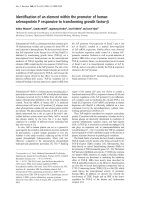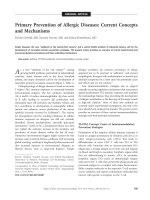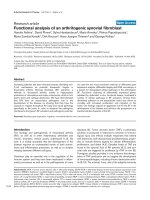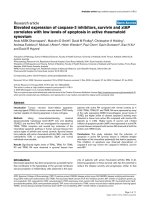Báo cáo y học: "Spontaneous rupture of an infected renal cyst and external drainage through a lumbar surgical scar in a male patient with cervical spinal cord injury: a case report" doc
Bạn đang xem bản rút gọn của tài liệu. Xem và tải ngay bản đầy đủ của tài liệu tại đây (533.09 KB, 4 trang )
BioMed Central
Page 1 of 4
(page number not for citation purposes)
Journal of Medical Case Reports
Open Access
Case report
Spontaneous rupture of an infected renal cyst and external drainage
through a lumbar surgical scar in a male patient with cervical spinal
cord injury: a case report
Subramanian Vaidyanathan*
1
, Peter L Hughes
2
, Tun Oo
1
and Bakul M Soni
1
Address:
1
Regional Spinal Injuries Centre, District General Hospital, Southport, PR8 6PN, UK and
2
Department of Radiology, District General
Hospital, Southport, PR8 6PN, UK
Email: Subramanian Vaidyanathan* - ;
Peter L Hughes - ; Tun Oo - ;
Bakul M Soni -
* Corresponding author
Abstract
Introduction: The spontaneous rupture of an infected renal cyst is a rare event. Spontaneous
rupture with drainage to the exterior through a surgical scar has not been reported previously.
Case presentation: A 49-year-old male with tetraplegia had undergone extended right
pyelolithotomy in 1999. Deroofing and marsupialisation of a cyst in the upper pole of the right
kidney was performed in 2003. Subsequently there was recurrence of a thick-walled cystic space-
occupying lesion in the upper pole of the right kidney. Thick pus was aspirated from the renal cyst
on six occasions between September 2003 and November 2004. In March 2006, ultrasound
examination revealed a cyst measuring 6.2 cm in diameter in the upper pole of the right kidney.
Aspiration was planned when the renal cyst reached 7.5 cm in diameter. However, 11 months later,
the cyst ruptured spontaneously and drained through the previous surgical scar in the flank, while
the patient was recovering from a severe chest infection in the spinal unit. Ultrasound examination
showed a fistulous tract running between the renal cyst and the abdominal wall. Repeated minor
trauma sustained during turning, hoisting and chest physiotherapy all may have contributed to the
rupture of the infected renal cyst and drainage through a weak spot in the abdominal wall.
Conclusion: In hindsight, we might have prevented rupture of the renal cyst had we considered
aspiration of the renal cyst before it reached 7.5 cm in diameter, although this 7.5 cm diameter, as
the threshold for percutaneous aspiration, is an arbitrary setting. This patient could have been
advised to wear an abdominal corset to protect the right flank from pressure applied
unintentionally during turning, hoisting or assisted coughing.
Introduction
Spontaneous rupture of a renal cyst is a rare event that
may occur into the pelvicalyceal system, the perirenal
space, or the peritoneal cavity [1]. We present the case of
a tetraplegic patient in whom an infected renal cyst rup-
tured spontaneously through a surgical scar in the ipsilat-
eral flank. A search in PubMed revealed no other reports
of rupture of the renal cyst to the exterior through a surgi-
cal scar either in ambulatory individuals or in persons
with a spinal cord injury.
Published: 14 May 2008
Journal of Medical Case Reports 2008, 2:154 doi:10.1186/1752-1947-2-154
Received: 21 May 2007
Accepted: 14 May 2008
This article is available from: />© 2008 Vaidyanathan et al; licensee BioMed Central Ltd.
This is an Open Access article distributed under the terms of the Creative Commons Attribution License ( />),
which permits unrestricted use, distribution, and reproduction in any medium, provided the original work is properly cited.
Journal of Medical Case Reports 2008, 2:154 />Page 2 of 4
(page number not for citation purposes)
Case presentation
A 49-year old male sustained C-6 complete tetraplegia in
1975. He underwent extended right pyelolithotomy in
1999. In 2003, this patient noticed a lump on the right
side of the abdomen. A computed tomography (CT) scan
of the abdomen revealed several large cysts in the right
kidney (Figure 1). Open surgical deroofing and marsupi-
alisation of a large cyst in the upper pole of the right kid-
ney were carried out in August 2003. Subsequently, there
was recurrence of a thick-walled cystic space-occupying
lesion in the upper pole of the right kidney containing
reflective fluid, which was consistent with an infected cyst.
Thick pus was aspirated from the infected renal cyst on six
occasions since September 2003; the last aspiration was
performed in November 2004. Microbiology of the aspi-
rate revealed the growth of coliforms. In March 2006, an
ultrasound scan revealed a cyst measuring 6.2 cm in diam-
eter in the upper pole of the right kidney. The wall of the
cyst was mildly, uniformly thickened with no irregularity.
The cyst contained clear fluid. There was a further adjacent
3 cm simple cyst at the upper pole of the right kidney with
associated calculi. Gallstones were noted in the gallblad-
der. The left kidney contained small cysts. As there was no
clinical or sonographic evidence of infection in the right
renal cysts, the patient was kept under observation.
In November 2006, the patient developed chest infection
and required mechanical ventilation. During this admis-
sion, medical care was focused on the patient's chest con-
dition, and understandably the renal cyst was not given
priority in investigation or treatment. In February 2007,
the patient had been weaned off the ventilator but he was
still requiring intense chest physiotherapy. While turning
the patient, nurses noticed a swelling in the middle of the
right flank scar. After two days, the swelling burst and
purulent material drained on to the skin. Microbiology of
the purulent discharge revealed the growth of Providencia
stuartii. This patient did not develop a fever, shivering or
any other indicative feature of infection. Ultrasound
examination showed a fistulous tract running between the
renal cyst and the abdominal wall. A CT scan of the abdo-
men was performed to look for any collection of pus in
the perinephric space. The CT scan revealed loss of the fat
plane between the mid-pole of the right kidney and the
postero-lateral abdominal wall (Figure 2). This was con-
tiguous with a 4 × 2 cm area of soft tissue thickening and
fluid collection in the subcutaneous fat. There was a small
pocket of gas. There was extruded calcific material from
the right kidney antero-lateral to the psoas muscle. On
sagittal reconstruction of the CT scan, a communication
between the cyst in right kidney and exterior through a
defect in abdominal muscles could be seen distinctly (Fig-
ure 3). The amount of purulent discharge draining
through the flank wound decreased gradually over a
period of 10 weeks. The patient remained afebrile. This
patient was scheduled for aspiration of the remaining
cysts in the right kidney once the infective process sub-
sided.
Axial CT scan of the abdomen, performed on 5 March 2007Figure 2
Axial CT scan of the abdomen, performed on 5
March 2007. Cysts in upper pole of right kidney are shown,
the largest measuring 7 cm. In contrast to Figure 1, there was
a marked loss of fat plane between the mid-pole of the right
kidney and the postero-lateral abdominal wall.
Axial CT scan of the abdomen, performed on 7 July 2003Figure 1
Axial CT scan of the abdomen, performed on 7 July
2003. Several cysts are shown in the right kidney, the largest
measuring 6 cm in diameter. The outline of the right kidney
was intact. The perirenal fat was seen without any disconti-
nuity. The gall bladder contained several stones.
Journal of Medical Case Reports 2008, 2:154 />Page 3 of 4
(page number not for citation purposes)
Discussion
A simple renal cyst is the most common abnormality
observed during routine ultrasound examination of the
kidneys in asymptomatic spinal cord injury patients, and
does not usually warrant any intervention [2]. A renal cyst
may be infected, albeit rarely. An infected renal cyst can be
distinguished from a simple renal cyst by magnetic reso-
nance imaging, as an infected renal cyst is less intense
than a simple renal cyst on T2 weighted imaging [3]. An
infected renal cyst requires drainage without delay [4];
otherwise, the infected cyst may rupture due to increased
intracystic pressure as well as weakening of the thin tissue
walls separating the cyst from a closely adjacent collecting
system or perinephric space [5]. Very rarely, rupture of an
infected renal cyst may result in fatal consequences [6].
Spontaneous rupture of an infected renal cyst can pose
diagnostic difficulties [7]. A patient with spontaneous
rupture of infected renal cyst may present to the emer-
gency department, with distension of the right flank
occurring suddenly [8].
In the case of our patient, when the renal cyst ruptured,
the surgical scar in the ipsilateral flank proved to be the
path of least resistance. Drainage of infected material
externally through the previous surgical scar helped to
prevent systemic infection. If such a weak spot had not
existed, the infected cyst might have ruptured into the ret-
roperitoneum resulting in inflammation of the perine-
phric space and collection of pus, which would have
required percutaneous or open surgical drainage.
Unlike ambulatory individuals, tetraplegic patients are at
greater risk of sustaining blunt trauma to the abdomen
during their routine activities of daily living. Paulson et al
[9] reported rupture of the spleen in a tetraplegic patient,
who slid sideways, catching his flank between the wheel-
chair arm and a slightly reclined wheelchair back. In our
patient, there was no history of acute trauma to the abdo-
men prior to the rupture of the renal cyst. However,
repeated minor trauma, sustained during routine activi-
ties of daily living, could have played a significant role in
the rupture of the renal cyst in this tetraplegic patient. For
example, it has been documented that men with spinal
cord injury can sustain blunt trauma to the scrotum dur-
ing transfers to a toilet seat or a car seat [10]. In the
reported cases, the scrotum was compressed by the weight
of the body during transfers or the scrotum was trapped
between the thighs. Analogous to the blunt trauma to the
scrotum incurred during transfers, it is conceivable that, in
our patient, the renal cyst situated under the surgical scar
was subjected to minor trauma during turning in bed or
while hoisting. Further, the right flank might have been
subjected to pressure against the side plate of the wheel
chair, as the tetraplegic patient was sat up on the chair.
The cyst in the right kidney would have been exposed to
increased pressures during vigorous chest physiotherapy
(for example, assisted coughing), which this patient
required because of a severe chest infection. The cumula-
tive effect of repeated minor trauma possibly led to rup-
ture of the infected renal cyst in this patient through a
weak spot, that is, a previous surgical scar in the flank.
From this case, we have learnt the following lessons.
• We should have recognised that the renal cyst was vul-
nerable to rupture, and should have carried out aspiration
of the renal cyst before it reached 7.5 cm in diameter,
although a size of 7.5 cm in diameter as the threshold for
percutaneous aspiration is an arbitrary setting. This would
have prevented rupture of the renal cyst.
• We should have advised this patient to wear an abdom-
inal corset, in order to protect the renal cyst and the surgi-
cal scar in the flank from pressures applied
unintentionally to the lumbar region during hoisting or
assisted coughing. We already use abdominal corsets in
thin patients, in whom a Medtronic pump has been
implanted in the abdominal wall for continuous intrath-
ecal delivery of baclofen.
Sagittal reconstruction of the CT scan of the abdomen, per-formed on 5 March 2007Figure 3
Sagittal reconstruction of the CT scan of the abdo-
men, performed on 5 March 2007. Communication
between the cyst in the right kidney and the exterior through
a defect in the anterior abdominal wall musculature is
revealed.
Publish with BioMed Central and every
scientist can read your work free of charge
"BioMed Central will be the most significant development for
disseminating the results of biomedical research in our lifetime."
Sir Paul Nurse, Cancer Research UK
Your research papers will be:
available free of charge to the entire biomedical community
peer reviewed and published immediately upon acceptance
cited in PubMed and archived on PubMed Central
yours — you keep the copyright
Submit your manuscript here:
/>BioMedcentral
Journal of Medical Case Reports 2008, 2:154 />Page 4 of 4
(page number not for citation purposes)
Conclusion
We have reported the case of a tetraplegic patient in whom
an infected cyst in the upper pole of the right kidney rup-
tured spontaneously and drained its contents to the exte-
rior through a surgical scar in the ipsilateral flank.
Spontaneous rupture of a renal cyst is a very rare event and
external drainage through a previous surgical scar has not
been reported previously in persons with spinal cord
injury. This tetraplegic patient possibly sustained repeated
minor trauma to his flank during turning, hoisting and
chest physiotherapy, which contributed to the rupture of
the renal cyst. In hindsight, we should have anticipated
that the renal cyst was at risk of rupture and should have
observed precautionary measures, such as aspiration of
the cyst even before it reached 7.5 cm in diameter. Further,
this patient should have been prescribed an abdominal
corset to protect the renal cyst and the surgical scar from
pressures applied unintentionally to the lumbar region
during turning, hoisting and chest physiotherapy.
Competing interests
The authors declare that they have no competing interests.
Authors' contributions
SV developed the concept for this case report and wrote
the draft. PLH provided the medical images. TO provided
clinical care. All authors contributed to the final manu-
script.
Consent
Written informed consent was obtained from the patient
for publication of this case report and accompanying
images. A copy of the written consent is available for
review by the Editor-in-Chief of this journal.
References
1. Nussbaum A, Hunter TB, Stables DP: Spontaneous cyst rupture
on renal CT. AJR Am J Roentgenol 1984, 142:751-752.
2. Vaidyanathan S, Hughes PL, Soni BM: A comparative study of
ultrasound examination of urinary tract performed on spinal
cord injury patients with no urinary symptoms and spinal
cord injury patients with symptoms related to urinary tract:
do findings of ultrasound examination lead to changes in clin-
ical management? Scientific World Journal 2006, 6:2450-2459.
3. Takashima M, Miyazaki K, Asari T, Fujita Y, Ikeda D, Yoshida M: A
case of infected renal cyst: the usefulness of magnetic reso-
nance imaging for preoperative diagnosis. Hinyokika Kiyo 1993,
39:837-839.
4. Koh E, Kondoh N, Kiyohara H: A case of infected solitary renal
cyst treated with percutaneous puncture and drainage.
Hinyokika Kiyo 1991, 37:381-384.
5. Papanicolaou N, Pfister RC, Yoder IC: Spontaneous and trau-
matic rupture of renal cysts: diagnosis and outcome. Radiol-
ogy 1986, 160:99-103.
6. Finlay DB, Lowe JS, Kaur K: Perforation of a suppurative solitary
renal cyst. Br J Surg 1981, 68:585-586.
7. Yoshinaga A, Hayashi T, Ishii N, Yoshida S, Ohno R, Terao T, Watan-
abe T, Yamada T: A case of spontaneous rupture of infectious
renal cyst with difficulty in diagnosis. Hinyokika Kiyo 2005,
51:257-259.
8. Tokuchi H, Yamamoto M, Kamoto T: Spontaneous rupture of
infected renal cyst presenting sudden onset of right flank dis-
tension: a case report. Hinyokika Kiyo 2004, 50:323-326.
9. Paulson SM, Hatvani C, Long C: Splenic rupture and splenec-
tomy due to fall from wheelchair. Arch Phys Med Rehabil 1983,
64:180.
10. Vaidyanathan S, Soni BM, Singh G, Subramaniam R, Bingley J, Sett P,
Parsons KF: Blunt trauma to scrotum in men with spinal cord
injury after they had completed rehabilitation in a spinal
unit. Spinal Cord 2001, 39:442-448.









